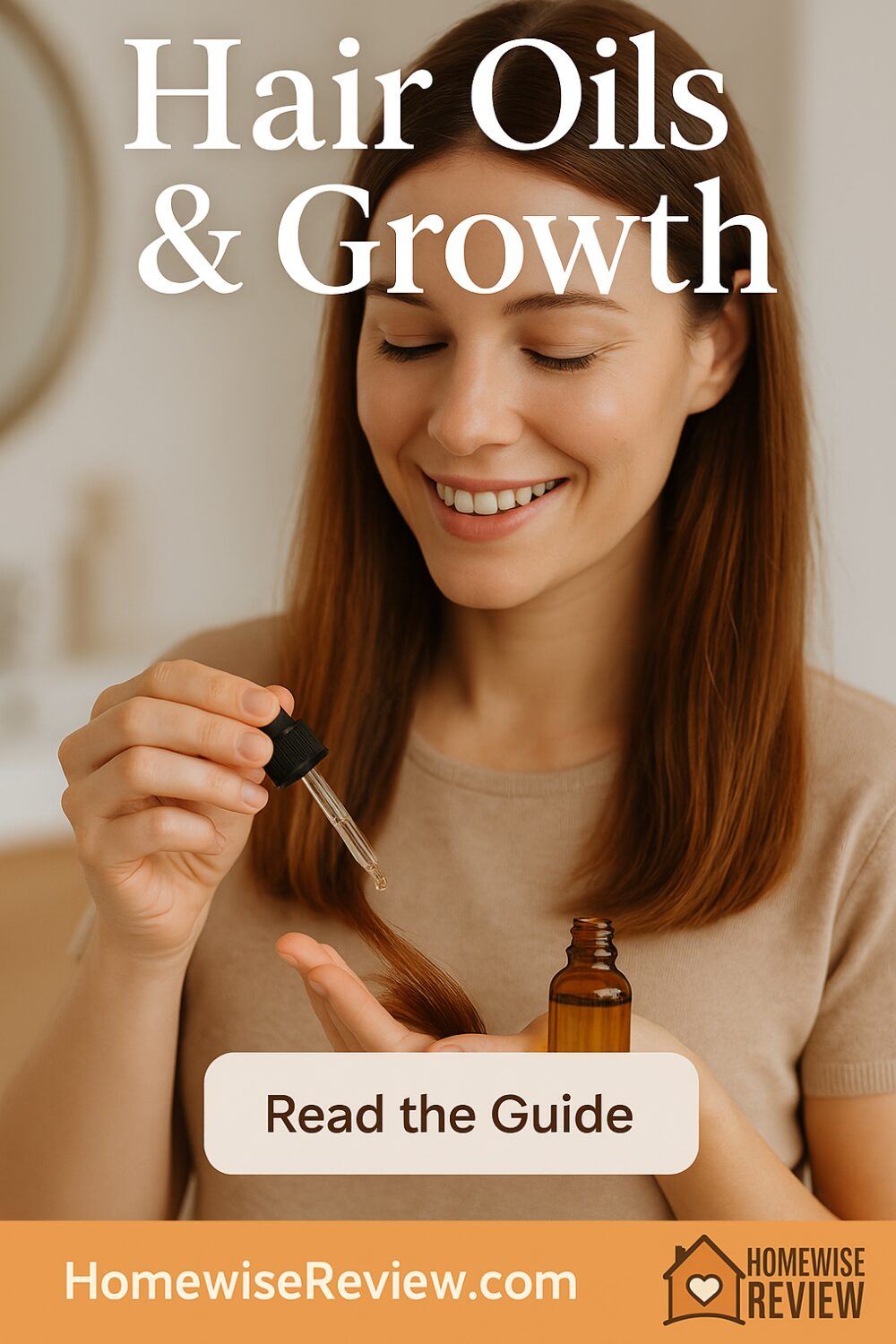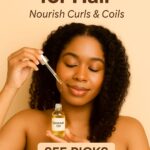
Hair oils can help you keep length by reducing breakage, softening frizz, and calming the scalp. They do not magically create new follicles. Real growth comes from a healthy scalp, smart wash routines, low tension, and time. Use this hub to choose the right oil by hair need, pick techniques that fit your porosity and style, and plug in care steps you can actually keep up with. Every tile below points to an article you already published, so you can follow the plan end to end today.
Start here
- How to Use Hair Oil (Without Grease, Breakage, or Buildup)
Foundation skills for when to oil, how much, and where to put it so you get shine and slip without limp roots. - Best Oils for Hair Growth (That Actually Help Your Hair Look Fuller)
Your big-picture chooser. Focuses on length retention, protective habits, and which oils play nicely with your wash cadence. - Product Layering to Avoid Flakes on 4C Hair
Stops gel and leave-in clashes that make hair look dull and dirty even when it is clean.
Pick an oil by hair goal
- Frizz control and shine
Read Best Hair Oils for Frizzy Hair to tame halo frizz without heavy waxy feel. If you prefer salon-brand blends by hair need, open Best Kérastase Oil for Hair (By Hair Need). - Lightweight slip for fine hair
Use Best Hair Oils for Fine Hair That Don’t Grease to get detangling and shine that will not collapse volume. - Growth support and retention focus
Target gentle scalp massage and less breakage with Best Oils for Hair Growth, then go deeper with Rosemary Oil for Hair Growth: What Actually Helps for protocol ideas you can repeat. - Stronger feeling hair during protective styles
For coils and tighter textures, Hot Oil Treatments for 4C Hair At Home shows a weekend reset that restores slip before you reinstall styles. - Hair that runs dry at the ends
Spot-treat with tried-and-true kitchen oils using Coconut Oil for Hair: When It Helps and Best Olive Oils for Hair and How To Use Them. For silky slip that feels lighter, see How to Use Argan Oil for Hair.
Ingredient spotlights
- Rosemary
See Rosemary Oil for Hair Growth for what is realistic, how often to use it, and how to combine with scalp-friendly shampoos. - Jamaican Black Castor Oil
Open Jamaican Black Castor Oil for Hair Growth: What It Can (and Can’t) Do to set expectations and learn smart ways to thin it or focus it on ends. - Argan
How to Use Argan Oil for Hair covers mid-length application and heat-styling support without greasy feel. - Coconut and Olive
Pair Coconut Oil for Hair and Best Olive Oils for Hair with low-porosity strategies so you get softness without film. - Blend-first salon oils
Best Kérastase Oil for Hair (By Hair Need) maps blends to frizz, dullness, and heat styling.
Scalp health is growth health
- Dandruff and flakes
Follow Best Scalp Treatments for Dandruff to pick an active and set a schedule. Oils can soothe, but dandruff needs actives first. - Build up and rough feel
Use Best Scalp Scrubs for Build Up on Natural Hair to reset, then switch to smarter wash chemistry. - Clarifying vs chelating
Read Chelating vs Clarifying Shampoo: What Each Does and When to Use so hard water and swimmer build up do not choke shine or block slip. - Scalp acne and tender roots
Scalp Acne Basics shows gentle exfoliation and product swaps that stop recurring bumps without wrecking your barrier.
Match the routine to hair type and porosity
- Low porosity hair
Start with Best Shampoos for Low Porosity Hair so oils can actually get in. Warm the oil in hands, apply sparingly, and always seal after water-based hydration. - 4C and protective styles
Plan maintenance with Nighttime Routine for Natural Hair That Prevents Breakage, protect edges with Edge Care Routine for Protective Styles, and keep airflow and moisture balanced using Scalp Care Under Wigs Keep Growth Going. - Color-treated hair
Keep pigments safe while you oil by using Best Shampoo for Colored Hair and spacing clarifying or chelating as the guide suggests.
Wash day templates you can copy
Template A: Once-a-week wash with oil seal
- Pre-wet and cleanse based on Sulfate Free Shampoos for Natural Hair That Actually Clean.
- Condition for slip.
- On damp hair, apply a light oil from Best Hair Oils for Fine Hair or a few drops of argan mid-lengths to ends.
- Style, then hands-off until next wash.
Template B: Protective style care
- Every 3 to 4 days, cleanse scalp with a targeted rinse from Best Scalp Treatments for Dandruff if you are flaking.
- Very light oil on exposed lengths only.
- Nightly edge routine from Edge Care Routine for Protective Styles to reduce tension.
- Weekly refresh with Hot Oil Treatments for 4C Hair At Home before reinstall or restyle.
Template C: Gym and sweat reset
- Quick scalp cleanse based on Scalp Acne Basics.
- Rinse lengths, apply a tiny amount of Kérastase style oil, and diffuse cool.
- Full wash next planned day.
What about “growth” treatments beyond oils
Oils help with retention and comfort. If you want a true growth active, read Rogaine for Women 5% Minoxidil Foam Deep Dive for what it does, who it is for, and how to use it with a simple oil routine that does not interfere.
Troubleshooting
- Greasy roots, dry ends
Move oil down the strand. Put a pea-size on palms, rub to warm, then pat mid-lengths and ends only. Use a root refresher on off days. - Flakes after oiling
You likely have product clash. Revisit Product Layering to Avoid Flakes on 4C Hair and reduce leave-in quantity before oiling. - Itchy scalp
Treat the cause first with Best Scalp Treatments for Dandruff or the routines in Scalp Acne Basics, then reintroduce oils lightly. - No shine payoff
Clarify or chelate per Chelating vs Clarifying. Mineral film can hide gloss no matter how much oil you add.
Final Thoughts
Healthy length is mostly about what you keep, not what you gain in a week. Pick an oil that fits your hair type and finish goal, clean the scalp with the right chemistry, and layer products so they work together. Build a weekly template you can repeat, protect edges and ends, and let time do the rest. The guides above give you everything you need using products and steps you can find easily and stick with.
See also
If you are getting started or rebooting an oil routine, begin with How to Use Hair Oil (Without Grease, Breakage, or Buildup), then open Best Oils for Hair Growth (That Actually Help Your Hair Look Fuller) to pick a targeted bottle. If you want a simple once-a-month reset that boosts shine, Chelating vs Clarifying Shampoo: What Each Does and When to Use explains how to clear hard water haze without stripping your ends.
If your scalp is the limiting factor, Best Scalp Treatments for Dandruff lays out actives that calm flakes, and Rosemary Oil for Hair Growth: What Actually Helps shows a gentle massage protocol you can slot around those wash days.
FAQs
1) Do hair oils make hair grow faster?
Oils do not create new follicles. They help you keep length by reducing breakage and improving slip so hair survives styling and detangling.
2) How often should I oil my scalp?
Only if your scalp is dry and happy with oil. Many people get the best results by oiling lengths and keeping the scalp focused on targeted treatments from your dandruff or acne guides.
3) Which oil penetrates versus seals?
Coconut can penetrate and reduce protein loss on some hair types. Argan and many blend oils mostly smooth and seal the cuticle for shine. Your ingredient spotlights detail how to use each.
4) Can I combine oils with a growth active like minoxidil?
Yes, but keep them separate. Apply minoxidil as directed to a clean scalp. Use light oil on mid-lengths and ends later in the day so you do not dilute the active. See your minoxidil deep dive for timing.
5) What is the fastest way to see a difference?
Fix the wash chemistry first, clarify or chelate if needed, then add a light oil to mid-lengths and ends. You will see slip and shine the same day, and length retention follows as breakage drops.




